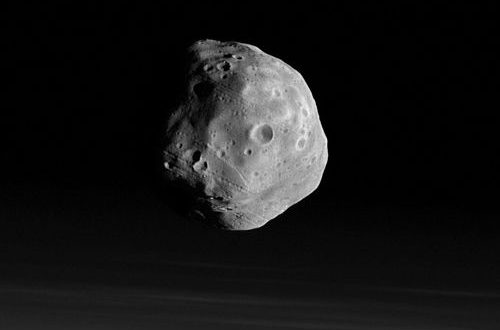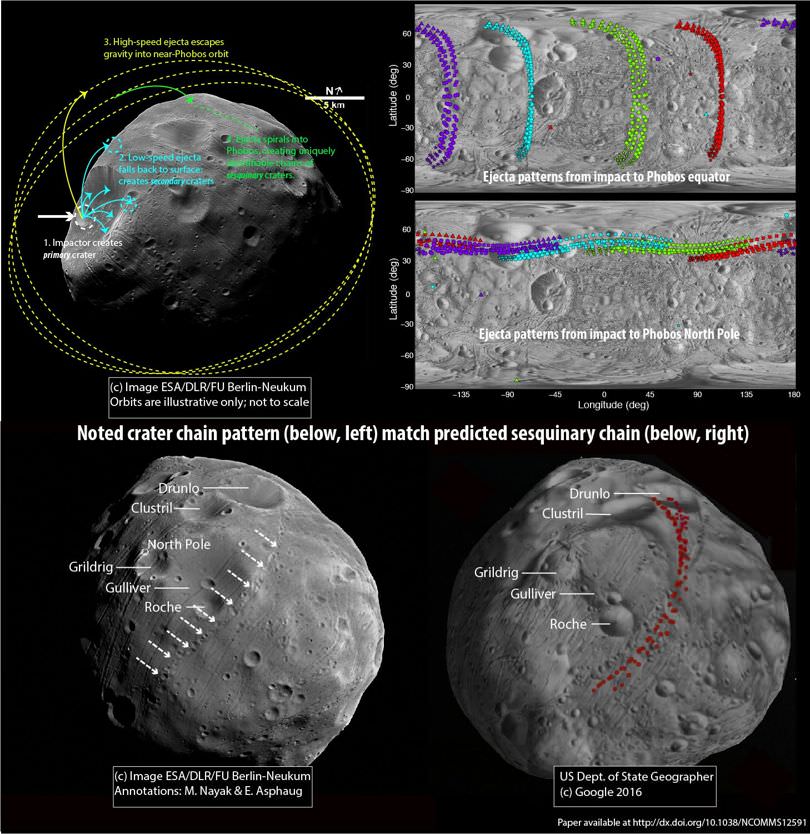Phobos, the largest Martian moon, will one day be ripped apart by the planet’s tidal forces – but it has already been significantly damaged as a result of its orbit.
Strange strings of craters etched into the largest of Mars’ moons formed when bits of rock from collisions were thrown into Martian orbit, whizzed around the red planet, then crashed back down on the satellite – ousting more debris and beginning the process again.
Computer modelling by Michael Nayak from the University of California, Santa Cruz and Arizona State University’s Erik Asphaug found if a meteorite struck Phobos at the right spot, its debris eventually created the distinct, linear groove patterns on the moon’s surface.
“A lot of stuff gets kicked up, floats for a couple of orbits and then gets recollected and falls back in linear chains before is has a chance to be pulled apart and dissociated by Mars’ gravity,” Nayak says.
Phobos is mostly at the mercy of the much-larger Mars’ gravitational pull.
Despite being the same density and 10 times the mass of other Martian moon Deimos, Phobos orbits much nearer – only around 9,300 kilometres from the red planet compared to more than 23,000 kilometres, in the case of Deimos.
What’s more, Phobos isn’t a solid chunk of rock – it’s more a conglomerate of pieces encased in a crust. (Deimos is the same.)
This close proximity and beanbag-like structure mean the moon is subjected to stretching and compressing tidal forces exerted by Mars. All this warping creates “stretch marks” of sorts called tidal fields that wrap around the moon like basketball stripes.
But there are some striations that run perpendicular to tidal fields – even across them – that can’t be explained by Martian tidal forces.
These grooves, if you look closely, are chains of craters perfectly spaced around the moon. How did they get there?
Nayak developed a simulation that tracked, in detail, where debris expelled by meteorite impacts ended up.
Because Phobos is so small and not terribly dense, detritus can easily escape its gravity.
But instead of flying out into space, the rubble encounters the much larger gravitational tug of Mars and is hooked into orbit, where it circles the planet just a little faster or slower than Phobos.
After a few orbits, the fragments catch up to Phobos (or the other way around) and fall back on the moon – which, in turn, throws up more debris.
If the initial impact hit the moon in certain spots, the next collisions formed a neat line of craters. A string of craters, Nayak and Asphaug write, could form within days.
To test their model, the pair applied it to a real-life crater.
When they simulated an impact at Gildrig, a 2.6-kilometre crater near Phobos’ north pole, they ended up with a feature that closely matched an actual crater chain.
When combined with tidal fields, Nayak says, these so-called sesquinary impacts “can explain most if not all of the grooves on Phobos”.
But Phobos’ unusual orbit and low mass means it may be the only place in the solar system these grooved crater chains emerge, he adds.
Agencies/Canadajournal
 Canada Journal – News of the World Articles and videos to bring you the biggest Canadian news stories from across the country every day
Canada Journal – News of the World Articles and videos to bring you the biggest Canadian news stories from across the country every day




